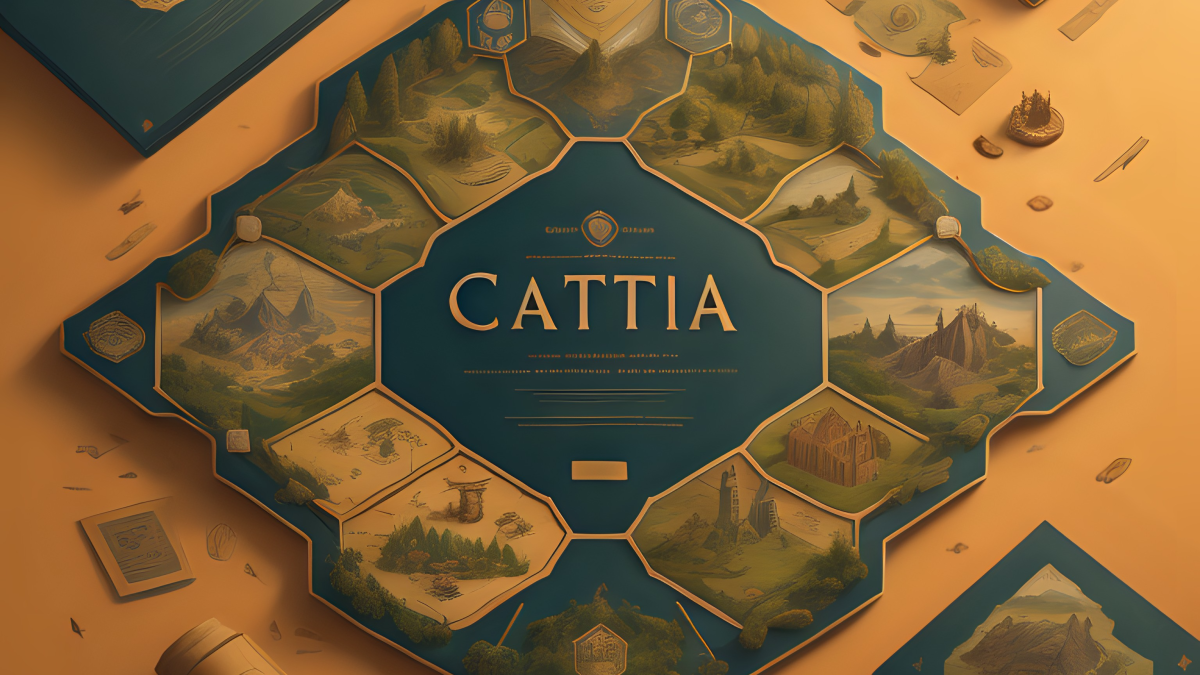
Like a yogi perched atop a mountain contemplating the vista below, have you ever pondered the strategy of settling new lands?
Embarking on the journey into the world of Catan is akin to stepping onto the mat for the first time; there's anticipation, uncertainty, and the promise of discovery. In Catan, as in yoga, there's a delicate interplay between careful planning and the fate of the dice roll, inviting players to adapt with mindfulness and strategy, much like a yogi adjusts their posture with breath and balance.
In strategic gameplay, The Settlers of Catan, commonly known as Catan, unfolds as a narrative of acquisition and development. Just as asanas form the foundation of a yoga practice, the hexagonal tiles represent the resources—grain, lumber, wool, brick, and ore—vital for constructing the infrastructures of your burgeoning settlements and cities. Mastery of Catan begins with learning how to effectively utilize these resources, akin to understanding how breath supports movement in yoga.
Navigating Catan's landscape requires strategic foresight and the ability to engage in diplomacy and trade, reminiscent of the connectivity fostered in a yoga community. Players seek to expand their domain through the strategic placement of roads and settlements, much like the expansion of one's practice through consistent dedication. Every decision in Catan echoes the cause and effect principle, an immutable law in both the game board's territory and on the yoga mat—karma in action.
Begin by assembling the hexagonal tiles to form the island of Catan, positioning them randomly to create a unique board each time.
Every Catan game starts anew, akin to the ever-changing nature of a yoga practice, reflecting endless possibilities for strategy and growth.
Arranging the resource tiles involves a balanced distribution, ensuring a mix of grain, lumber, wool, brick, and ore is equally accessible to all players. This mirrors the equanimity sought in yoga.
The sea's perimeter placement frames the island, while the numbers on each resource decide the production outcomes. Yogic attention to detail enhances strategic gameplay.
Strategic Development is a critical aspect akin to a yogi's progression in practice. Players must consider the optimal placement of roads, settlements, and cities to accrue valuable resources and points for victory.
Negotiation and trade are foundational to Catan's gameplay, reflecting the interconnectedness within a yoga community. Through shrewd bargaining with opponents, one acquires essential resources. The delicate balance of competition and cooperation can mean the difference between stagnation and a robust, thriving settlement, echoing the importance of personal growth and community support within yogic philosophy.
Resource management is also paramount in Catan. Acquiring and judicious use of grain, lumber, wool, brick, and ore correspond to maintaining a balanced personal practice. Mismanagement can lead to deficits and missed opportunities for advancement, highlighting vigilance and foresight as vital attributes.
Finally, the element of chance, introduced through the roll of dice, adds an unpredictable layer, much like the daily fluctuations in one’s physical and mental state. Adapting strategies to the whims of fortune is essential, underscoring the yogic concept of non-attachment. This acceptance and adaptability shape the journey toward enlightened play in Catan and the quest for equilibrium and flexibility in the tapestry of life’s experiences.
In mastering Catan's resource economy, one must develop a fluid and adaptable strategy. Resourceful players are attentive to the game board's dynamic nature, factoring in resource production probabilities based on the number of tokens assigned to each hex and the distribution of those hexes across the island. It is imperative to establish a diverse portfolio of resources, ensuring one is independent of a single type, thus mirroring the importance of a holistic approach in life. Trading efficiently while mindful of immediate needs and future developments is akin to judicious energy allocation in daily practice. The strategic stockpiling of resources for critical moments can be a turning point, just as retaining one's focus and composure is crucial in navigating life's complexities.
In Catan, trading with fellow participants is crucial for progress and growth. Engaging in exchanges, players aim to obtain resources that advance their developmental goals, reflecting the interdependence inherent in communal living. This aspect of Catan requires diplomatic understanding and strategic foresight, much like collaboration in life's various arenas.
Swift and savvy trading can propel a player toward victory. Negotiations must be shrewd and leverage positional advantages.
However, caution is advised when trading; over-generous terms can strengthen opponents. Every exchange (impactful either immediately or strategically) must be meticulously considered.
Offering trades aligned with long-term strategy is essential. Players must assess current needs against future opportunities, recognizing that inequitable trades can hamper progress.
Communicating effectively with opponents can heighten the chance of successful trading. Conveying convincing arguments for why an exchange benefits both parties can tip the scales in one's favor and forge valuable alliances.
Ultimately, the art of trading reflects life's need for reciprocation. Harmonious exchanges foster relationships and can lead to mutually beneficial outcomes, underscoring Catan's metaphor for thoughtful interaction.
Adept resource management is pivotal in constructing the roads, settlements, and cities that will lead to triumph in the realm of Catan.
With a monopoly on a particular resource, strategic trade embargoes can be implemented, yet a balanced portfolio ensures resilience against such tactics.
The scarcity or abundance of any resource type necessitates judicious trading strategies and foresight in placement to secure a steady flow of all resources, underpinning successful expansion and victory.
Expansion necessitates strategic road building to access new terrain, enabling broader resource acquisition, which is critical in reinforcing one's footprint on Catan's varied landscape.
Balancing between expansion and upgrading settlements into cities requires careful consideration; resources channeled in one direction may create short-term gains but hinder long-term development and point accumulation.
Ultimately, deft resource management to facilitate continuous growth and city upgrades ensures a robust and diversified dominion with the potential to secure a strategic advantage and the coveted victory points.
Strategic timing is critical for road development.
The decision to construct roads in Catan must stem from strategic considerations. The prime directive is to expand your reach for resource acquisition; therefore, roads are fundamental in connecting settlements and securing vital routes. They are also essential in the race to claim unoccupied land, mainly when aiming to build new settlements or secure the longest road, which grants additional victory points. Consequently, the reasonable timing of road construction can significantly influence your tactical positioning on the island.
Construct roads to reach essential resources or strategic points. Occupying the longest road can yield crucial victory points. Timing and foresight in road placement can affect your strategic outcomes, potentially leading you to triumph.
Roads should enable progressive development. Throughout gameplay, assess the geographic layout and resource accessibility, ensuring your road-building strategy aligns with your broader objectives—such as resource acquisition, settlement placement, or strategic connectivity—thus enhancing your potential for obtaining victory points.
Observe opponents' strategies and territory. Roads are not just a means to expand but can also act as barriers, preventing others from accessing critical areas. While road-building, be mindful of opponents' intentions and the distribution of resources on the board. This will allow you to adapt your strategy in a dynamic environment and maintain a competitive edge.
Continuously evaluate the status quo and adapt. As you progress through the game, reflect on your current resource stockpile, potential growth paths, the actions of your adversaries, and the evolving terrain. Weigh these factors diligently before constructing new roads, as each decision is integral to your quest for dominance in Catan. Sister publication: 'Catan Strategy and Tactics 2023' delineates advanced road-building methodologies enriching competitive gameplay further.
In Catan, the strategic establishment of settlements and cities is paramount, forming the crux of resource generation.
Expanding judiciously with settlements and cities can disrupt opponents' plans and secure essential resource nodes.
Leveraging settlements and strategically upgrading to cities are crucial imperatives to outmaneuver competitors in the intricate dance of Catan.
Engaging with fellow players is essential; the dynamics of trade and negotiation fuel the progress toward victory.
In Catan, forging alliances and bartering with astuteness can provide the resources needed for critical developments, such as settlements or city upgrades. Yet, it's paramount to remain vigilant of opponents' motives, ensuring your strategy isn’t compromised.
Effective diplomacy and strategic trade are cornerstones in Catan, significantly impacting the journey to the winning threshold.
In Catan, masterful negotiation and diplomacy can be as decisive as the dice roll.
Strategies in trade can pivot the balance of power swiftly.
Effective diplomacy involves the keen perception of both the board’s dynamics and opponents’ tendencies.
The robber serves as Catan's equalizer.
The rules governing the robber are tactically profound. When a seven is rolled, or a knight card is played, the player who enacted the action may relocate the robber to any terrain hex, interrupting resource production of that tile. Furthermore, should one or more rival settlements or cities be adjacent to the robber's new location, the moving player can steal a random resource card from one of those players.
Relocation should be deliberate, aiming to stifle opponents’ advantages. A well-positioned robber can cause significant disruption to a resource flow, directly influencing the pace at which your opponents can develop their settlements and cities.
The impact of the robber extends beyond mere resource denial. It introduces an element of strategic leverage, offering opportunities to negotiate with impacted players, potentially leading to the forging of new alliances or the redefinition of existing ones. Hence, be aware of the psychological undercurrents accompanying the robber's movement; they may very well shape diplomatic relations as the game progresses.

